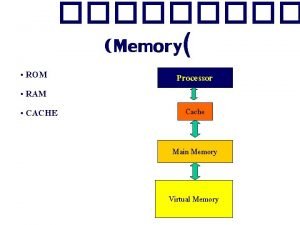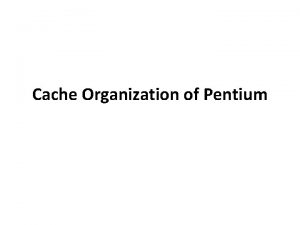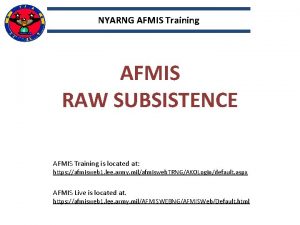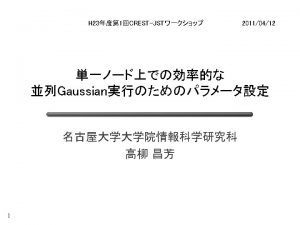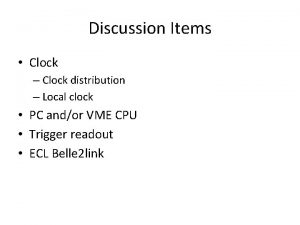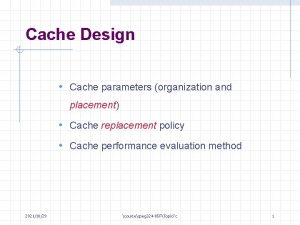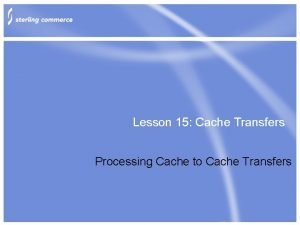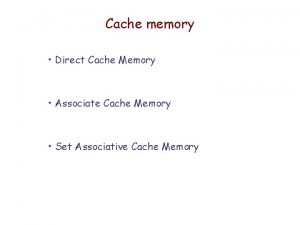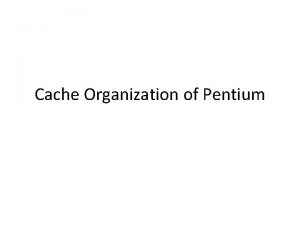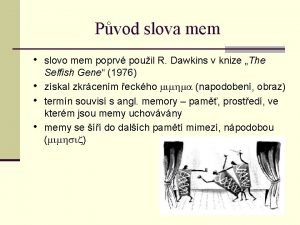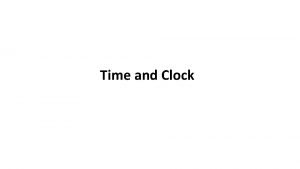Mem C 3 Mem Cache with CLOCK and























- Slides: 23

Mem. C 3: Mem. Cache with CLOCK and Concurrent Cuckoo Hashing Bin Fan (CMU) Dave Andersen (CMU), Michael Kaminsky (Intel Labs) Presenter: Shouqian Shi Credit to: Son Nguyen

Memcached • DRAM-based keyvalue store to alleviate database load – Set(key, value) – Get(key) -> value

Memcached • LRU (Least Recently Used) eviction • Often used for small objects (Facebook [Atikoglu 12] – 90% keys < 31 bytes • 10 x. M queries per second (Facebook [Atikoglu 12] ) )

Memcached internal • Chaining hashtable • LRU caching using doubly linked list Global Lock Huge Space Overhead

Goals • Target: read-intensive workload with small objects • Reduce space overhead (bytes/key) • Improve throughput (queries/sec) – Result: 3 X throughput, 30% more objects

Mem. Cachd: Chaining Hashtable • Use linked list – costly space overhead for pointers • Pointer dereference is slow (no advantage from CPU cache) • Read is not constant time (due to possibly long list)

Cuckoo Hashing • Use 2 hash functions to pick two candidate positions • Each bucket has exactly 4 slots (fits in CPU cache) • Each (key, value) object therefore can reside at one of the 8 possible slots HASH 1(ka) (ka, va) HASH 2(ka)

Cuckoo Hashing X X Insert a: X HASH 1(ka) ba X X X X X c X X X (ka, va) HASH 2(ka) X X X

Cuckoo Hashing X X Insert b: X HASH 2(kb) a X X X X X bc X X X (kb, vb) HASH 1(kb) X X X

Cuckoo Hashing X X X a X Insert c: X HASH 1(kc) c X X X X b X X X (kc, vc) HASH 2(kc) X Done !!! X X

Cuckoo Hashing • Read: 4 lookups on average • Write: write(ka, va) – Find an empty slot in 8 possible slots of ka – If all are full then randomly kick some (kb, vb) out – Now find an empty slot for (kb, vb) – Repeat 500 times or until an empty slot is found – If still not found then do table expansion

Cuckoo’s advantages • Concurrency: multiple readers/single writer • Read optimized (entries fit in CPU cache) • Still O(1) amortized time for write • 30% less space overhead • 95% table occupancy

Floating Problem • Always one guy is outside during the insertion – false cache miss • Solution: Compute the kick out path (Cuckoo path) first, then move items backward

Computed Cuckoo path X X Insert a: X HASH 1(ka) b X X X X X c X X X (ka, va) HASH 2(ka) X X X

Cuckoo path backward insert X X Insert a: X HASH 1(ka) ba X X X X X c X X (ka, va) HASH 2(ka) X X X

Cuckoo and optimistic lock

Mem. Cachd: Doubly-linked-list • At least two pointers per item – expensive for small key-value pair • Both read and write update the position – change the list’s structure – need locking between threads (no concurrency)

Solution: CLOCK-based LRU • Only for multiple readers / single writer • Approximate LRU • Circular queue instead of linked list – less space overhead – 1 bit per entry vs 16 Bytes

CLOCK example Originally: entry recency entry Read(kd): Write(kf, vf): Write(kg, vg): recency entry recency (ka, va) (kb, vb) (kc, vc) (kd, vd) (ke, ve) 0 1 0 0 1 (ka, va) (kb, vb) (kc, vc) (kd, vd) (ke, ve) 0 1 0 (ka, va) (kb, vb) (kf, vf) 0 0 1 (kg, vg) (kb, vb) (kf, vf) 1 0 1 1 1 (kd, vd) (ke, ve) 0 0

Eviction and lock

Evaluation 68% throughput improvement in all hit case. 235% for all miss

Evaluation 3 x throughput on “real” workload

Discussion • Single machine multi-core optimization – no cooperation between machines – need a load balancer – cannot address hotspot on the cluster level • Atomic insertion – lock along the path • The impact of hotspot false eviction?
 Fast clock to slow clock synchronization
Fast clock to slow clock synchronization 60 minutes in hour
60 minutes in hour Cache rom
Cache rom Advantages of direct mapping
Advantages of direct mapping Cache attacks and countermeasures: the case of aes
Cache attacks and countermeasures: the case of aes Alteryx cache and run workflow
Alteryx cache and run workflow Page fault
Page fault Cache level 3 diploma in childcare and education
Cache level 3 diploma in childcare and education Explain cache organization of pentium processor
Explain cache organization of pentium processor Samsun mem
Samsun mem Main mem
Main mem Excel mem
Excel mem Https://unifiedportal-mem.epfindia.gov.in/
Https://unifiedportal-mem.epfindia.gov.in/ Phần mềm htkd vnpt
Phần mềm htkd vnpt Loada mem
Loada mem Gugel trans
Gugel trans Vav hei vav
Vav hei vav Tcp to memsql
Tcp to memsql Ahp
Ahp Vẽ lều trại
Vẽ lều trại để khởi động phần mềm paint
để khởi động phần mềm paint Basic cisco device configuration
Basic cisco device configuration Afmis
Afmis Shadow mem
Shadow mem


